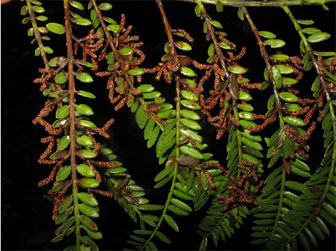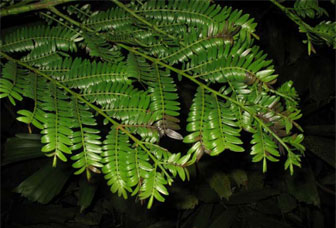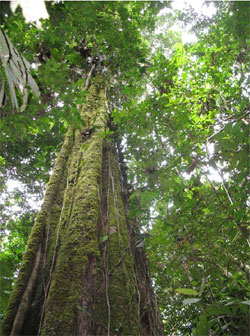New tree species discovered in the Peruvian Amazon
New tree species discovered in the Peruvian Amazon
Dr. Devon Graham, Project Amazonas, Inc
Special to mongabay.com
August 17, 2008
I was walking down the Anaconda Trail at the Madre Selva Biological Station with botanist Rodolfo Vasquez when he suddenly stopped, stared at the bark of a 120-foot tree, and started searching the ground. Odd behavior? Perhaps, but when you’re with Peru’s top field botanist, odd behavior is forgivable, since it means that something interesting is probably afoot.
It didn’t take Rodolfo long to find what he was looking for — broken off branches and twigs with small leaves arranged in a single plane and interspersed with tiny cones. Yes cones, as in the pine-cone type of cone. Tipped off by bark that was similar to a tree he knew from the Andes Mountains, Vasquez, a field botanist with the Missouri Botanical Gardens, had discovered a conifer growing in the humid rainforest of the Peruvian Amazon lowlands. The only problem was that there aren’t supposed be any conifers growing on clay soils at in lowland rainforest just south of the equator. The presence of cones and the unique arrangement of the leaves confirmed that the tree was a species of Retrophyllum, a genus in the Podocarpaceae which is a group of conifers widely distributed in the southern hemisphere. To Rodolfo’s dismay, however, the tree was a male, as confirmed by the tiny pollen producing cones. While most plants combine male and female parts on the same plant and even in the same flowers, conifers typically have separate male and female plants. Plant taxonomy, however, is based largely on female floral, fruit, and seed characteristics, none of which are obtainable from a male plant. Without that additional material, it would be impossible to conclusively identify the new tree, or if it was an undescribed species, to formally describe it and give it a scientific name. We searched the surrounding area looking for additional individuals but without success. Our single male tree was destined to remain an anonymous bachelor, and he soon was dubbed “Lonely George” for lack of a better name.
 Pollen producing male cones of Retrophyllum sp. from Madre Selva |
The lack of a name notwithstanding , the mystery remains – what is a conifer doing growing where it isn’t supposed to be. Conifers in the Podocarpaceae family are mostly plants of temperate regions, growing well south of the equator in temperate zones, or at high elevations where temperatures are cooler. The genus Retrophyllum, to which Lonely George belongs, is itself a lonely offshoot of the Podocarpaceae. There are 5 described species, all of which are listed by the International Union for the Conservation of Nature as endangered or threatened by habitat loss and/or logging. One species, Retrophyllum rospigliosi, grows in the Andes Mountain foothills at elevations of 5000-7000 feet, well above the 300-350 foot elevations of the Madre Selva station. Another is known from a single mountain range in Rondonia, Brazil, a thousand miles distant. The other three species occur in New Caledonia, Fiji, New Guinea, the Solomon Islands and Indonesia, in the South Pacific. Fossil pollen and leaves indicate that the genus was once abundant and widespread throughout the Southern Hemisphere, and particularly in Australia and New Zealand, though it has been extinct in there for eons. Considering the habitat and geographic location in which Lonely George grows, it is probable that he represents a new and undescribe d species of large and distinctive tree.
 A twig of Retrophyllum sp. from Madre Selva Biological Station, Loreto, Peru |
Lonely George’s very existence is somewhat fortuitous to start with. The Madre Selva Biological Station was founded by Project Amazonas in 1994 on lands that had been partially used for slash-and-burn agriculture. The area had also been selectively logged 10-15 years previously, and the scars of tractor trails are still visible less than 100 yards from Lonely George’s position. Although the Andean species are highly valued as timber, it is likely that the loggers didn’t recognize the timber value of the single tree, and concentrated on cutting trees with known market value instead. That commercial loggers wouldn’t know the value of a particular tree species is not surprising, considering the high diversity of trees in lowland Amazonian rainforests. At Madre Selva, a 1-hectare (2.47 acre) marked tree plot contains 640 trees measuring 10 cm or greater in diameter at breast-height. Those 640 trees are divided up among over 310 distinct tree species, a truly amazing diversity where every other tree is essentially a different species. Most US states can’t boast of having over 300 tree species, and yet two-and-a-half acres of Amazon rainforest can have that number of species. An adjacent plot of land may have many additional species not found in the first plot.
 Retrophyllum tree |
With a few common and widespread tree species, and many many rare and widely dispersed ones, Lonely George’s predicament isn’t uncommon. For pollination, rare trees may be selfcompatible (able to fertilize themselves), depend on specialized pollinators with the capability of traveling over long distances and locating other trees of the same species, or they may produce large quantities of pollen in the hopes that chance breezes carry some of the pollen to a distant tree of the same species. For trees with separate male and female plants, however, selfpollination isn’t an option, and what happens to a male tree if the nearest female tree is cut down? Does it become reproductively extinct? Hence the interest in finding a female tree within the Madre Selva protected area, since if there are any, they could be vulnerable to logging or cut down for garden patches. In consequence, the local population, and perhaps the entire species, could easily be wiped out. Every time I walk the Anaconda Trail, I keep an eye open for companions for Lonely George, and I always stop to pat his trunk as I go by. Numerous visitors have been introduced to George and had their portraits taken with him, but I always feel a bit sad as we pass by. Interkingdom affairs never produce any progeny, no matter how much love is involved.
It is July 2008 and I’m walking on the Fer-de-Lance Trail in another part of the Madre Selva Biological Station with a couple of students. Looking down at my feet as I negotiate a steep slope, I suddenly recognize the distinct twigs and leaves of a Retrophyllum tree. Yes, there is the distinctive bark as well, and off to the side of the trail there it is, another 100-foot plus tall conifer! Excitedly, I look around on the ground for additional evidence, and yes, there they are – cones, tiny cones, male cones. My excitement drops a notch, this tree won’t be a female companion for Lonely George, instead it is going to be another lonely male. We promptly dub it “Lonely John” (pictured above). I’m optimistic though — with two large mature male trees located, I feel that it is only a matter of time before we find a female tree. Once that happens, we’ll be able to definitively state whether or not these trees are a new species, or whether they are an extreme outlying population of one of the other two species known from South America. We’ll also be able to attempt to grow seedlings for planting in protected areas and for distribution to botanical gardens — this will serve as a buffer against extinction of the population or species. While it is possible that the tree may prove to be fairly widespread in the little studied area of Peru between the Orosa and Yavari Rivers, it could also be a relict population or species with a highly restricted geographic range. Whichever the case, Lonely George and Lonely John now have advocates looking out for their future and that of their species. I wonder though, how many other Amazon species might be driven to extinction though habitat loss before we ever have to the opportunity to become acquainted.
Project Amazonas, Inc., maintains and operates four biological reserves in the Peruvian Amazon. These are open for use by students, researchers, courses and ecotourists. Project Amazonas manages the sites in collaboration with local communities, and also engages in medical, education, and community development activities with isolated communities in the north-eastern Peruvian Amazon. For more information, visit Project Amazonas.
Dr. Devon Graham is a tropical biologist who has been involved with Project Amazonas since the fall of 1994, and who became president of the organization in 2000. When not working in the Peruvian Amazon with Project Amazonas, Dr. Graham hosts a variety of ecotours in the Amazon and elsewhere and also teaches in The Honors College at Florida International University in Miami, Florida.







